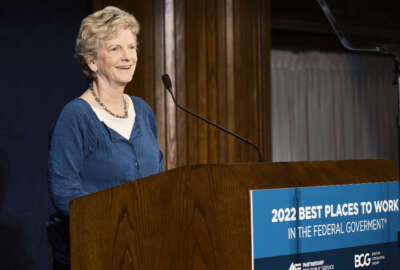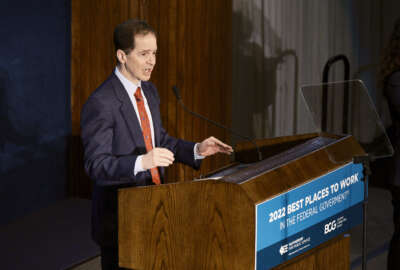

Among declining employee engagement trends in the Partnership for Public Service’s Best Places to Work results, some agencies still managed to shine.
Just 19 of the 74 agencies in the 2022 Best Places to Work in the Federal Government rankings either held steady or improved their employee engagement score.
But among many declining trends in the Partnership for Public Service’s results, some agencies still managed to shine.
“When we look at these averages, I think it’s so much more powerful when we pull apart and look at the variation across government and within agencies,” said Max Stier, the Partnership’s president and CEO, at a Best Places to Work ceremony Wednesday.
For one, the Small Business Administration’s engagement and satisfaction score increased by 6 points in 2022, moving from 70.7 in 2021, to 76.6 this year. It’s by far the highest score SBA has received since the annual rankings began in 2003.

The significant bump landed SBA in sixth place in the rankings for midsize agencies. In 2021, SBA was 16th in the rankings.
“We ensure that our employees understand that when we take surveys and they generate feedback for us, that leadership actually take actions on that feedback that’s coming in,” SBA Chief Human Capital Officer Elias Hernandez told Federal News Network at the Partnership event. “We help organizations within SBA to prepare action plans to improve in the areas that have been identified.”
Beyond creating action plans, it’s equally important to continuously monitor those plans and identify areas for ongoing improvement, Hernandez said. SBA has taken steps to expand training and development programs, strengthen work-life programs and support and ensure transparent communication from agency leaders.
But the crucial component for SBA to improve its score? Strong communication with employees.
“We take the feedback of our employees, we analyze the strategies that we have in place and we make modifications based on that feedback,” Hernandez said. “The key thing is for us to always communicate back to the employees that we are listening to them, we are taking action on the information and we are actually modifying the strategies to address their points of views.”
Of course, the work to continuously engage federal employees is never-ending. SBA’s human capital leaders are now turning their attention to specific areas of the annual Federal Employee Viewpoint Survey (FEVS) — the main source of data for the Partnership’s rankings. In particular, the “Leaders Lead” aspect of FEVS, which measures employees’ perceptions of federal leaders’ abilities, will be a central component to try to improve SBA further.
“We are working with agency leaders to identify ways to address areas identified for improvement within this index for next year and beyond. We are targeting efforts for those offices with ‘Leaders Lead’ scores below SBA’s overall score and tailoring the approach to the specific office,” Hernandez said later by email.
At the National Science Foundation, the score for engagement and satisfaction dropped from 86 to 82.8, but NSF still ranked second overall for midsize agencies.

The agency is looking for reasons behind the score change this year, and how leaders can approach solutions, said Wonzie Gardner, NSF’s chief human capital officer.
“I looked at that blip as trying to figure out how we work in a hybrid environment, or what I call more of a distributed environment. Communicating is key to that. And we need to do a better job communicating,” Gardner told Federal News Network at the Partnership event.
Looking to bump back up the rankings next year, Gardner said he’s targeting upskilling and reskilling as ways to try to improve agency retention and employee engagement and satisfaction.
“We’re also trying to make sure we give our managers and employees the soft skills that are needed now to work in this new environment,” Gardner said. “Things that we didn’t think about before are more important. How do we engage each other? How do we talk to each other when we’re on a screen that’s flat and the verbal and nonverbal cues that we used to rely on are not available anymore? I think it’s very important as we go through this new era that we learn new soft skills and make sure that we’re communicating and delivering the message that we need to.”
For the Department of Health and Human Services, which held onto its number two spot for large agencies, the focus will be on looking at strengths in some specific areas of its massive workforce, and adjusting other areas to replicate those successes.
“We have agencies who have been engaged in this kind of work in ways that others haven’t,” HHS Deputy Secretary Andrea Palm said at the Partnership event. “So, how do we lift all boats? How do we use what we know works in NIH, for example, in another part of the department, and vice versa. We’ve got lots of work to do.”
HHS largely held steady for its employee engagement and satisfaction score, which was 74.4 in 2021 and 74.3 in 2022.
The General Services Administration was another agency with a declining score, moving from 82.4 in 2021 to 81.0 in 2022, but the agency still ranked fourth overall for midsize agencies, holding onto a top-five position that it received in last year’s rankings as well. To maintain its status among the best places to work, GSA leaders said they try to incorporate suggestions from internal staff as often as possible.
“We use internal surveys to understand how we can better meet the needs of the folks on our team,” GSA Administrator Robin Carnahan said at the Partnership event. “We found that having these kinds of feedback loops, not just with our customers, is really important for us. That same kind of feedback loop internally, inside of our organization, is what helps keep our culture strong.”
To try to move up in the rankings and increase an overall score, patience is key.
“It’s not going to happen overnight,” Gardner said. “There has to be sincerity, commitment and transparency by senior leaders that this is important. This is not about lip service. It’s about actions.”
Copyright © 2024 Federal News Network. All rights reserved. This website is not intended for users located within the European Economic Area.
Drew Friedman is a workforce, pay and benefits reporter for Federal News Network.
Follow @dfriedmanWFED


